
A comet is an icy, small Solar System body that warms and begins to release gases when passing close to the Sun, a process called outgassing. This produces an extended, gravitationally unbound atmosphere or coma surrounding the nucleus, and sometimes a tail of gas and dust gas blown out from the coma. These phenomena are due to the effects of solar radiation and the outstreaming solar wind plasma acting upon the nucleus of the comet. Comet nuclei range from a few hundred meters to tens of kilometers across and are composed of loose collections of ice, dust, and small rocky particles. The coma may be up to 15 times Earth's diameter, while the tail may stretch beyond one astronomical unit. If sufficiently close and bright, a comet may be seen from Earth without the aid of a telescope and can subtend an arc of up to 30° across the sky. Comets have been observed and recorded since ancient times by many cultures and religions.

Comet Hale–Bopp is a comet that was one of the most widely observed of the 20th century and one of the brightest seen for many decades.
A trans-Neptunian object (TNO), also written transneptunian object, is any minor planet in the Solar System that orbits the Sun at a greater average distance than Neptune, which has an orbital semi-major axis of 30.1 astronomical units (AU).

2060 Chiron is a ringed small Solar System body in the outer Solar System, orbiting the Sun between Saturn and Uranus. Discovered in 1977 by Charles Kowal, it was the first-identified member of a new class of objects now known as centaurs—bodies orbiting between the asteroid belt and the Kuiper belt. Chiron is named after the centaur Chiron in Greek mythology.
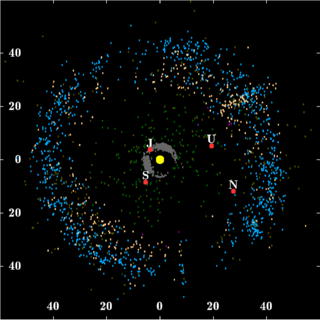
In planetary astronomy, a centaur is a small Solar System body that orbits the Sun between Jupiter and Neptune and crosses the orbits of one or more of the giant planets. Centaurs generally have unstable orbits because of this; almost all their orbits have dynamic lifetimes of only a few million years, but there is one known centaur, 514107 Kaʻepaokaʻawela, which may be in a stable orbit. Centaurs typically exhibit the characteristics of both asteroids and comets. They are named after the mythological centaurs that were a mixture of horse and human. Observational bias toward large objects makes determination of the total centaur population difficult. Estimates for the number of centaurs in the Solar System more than 1 km in diameter range from as low as 44,000 to more than 10,000,000.
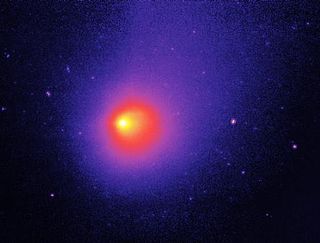
Comet 29P/Schwassmann–Wachmann, also known as Schwassmann–Wachmann 1, was discovered on November 15, 1927, by Arnold Schwassmann and Arno Arthur Wachmann at the Hamburg Observatory in Bergedorf, Germany. It was discovered photographically, when the comet was in outburst and the magnitude was about 13. Precovery images of the comet from March 4, 1902, were found in 1931 and showed the comet at 12th magnitude. It reached the last perihelion on March 7, 2019. It came to opposition in late December 2022.

67P/Churyumov–Gerasimenko is a Jupiter-family comet. It is originally from the Kuiper belt and has an orbital period of 6.45 years as of 2012, a rotation period of approximately 12.4 hours, and a maximum velocity of 135,000 km/h. Churyumov–Gerasimenko is approximately 4.3 by 4.1 km at its longest and widest dimensions. It was first observed on photographic plates in 1969 by Soviet astronomers Klim Ivanovych Churyumov and Svetlana Ivanovna Gerasimenko, after whom it is named. It most recently came to perihelion on 2 November 2021, and will next come to perihelion on 9 April 2028.

The scattered disc (or scattered disk) is a distant circumstellar disc in the Solar System that is sparsely populated by icy small Solar System bodies, which are a subset of the broader family of trans-Neptunian objects. The scattered-disc objects (SDOs) have orbital eccentricities ranging as high as 0.8, inclinations as high as 40°, and perihelia greater than 30 astronomical units (4.5×109 km; 2.8×109 mi). These extreme orbits are thought to be the result of gravitational "scattering" by the gas giants, and the objects continue to be subject to perturbation by the planet Neptune.

The nucleus is the solid, central part of a comet, formerly termed a dirty snowball or an icy dirtball. A cometary nucleus is composed of rock, dust, and frozen gases. When heated by the Sun, the gases sublime and produce an atmosphere surrounding the nucleus known as the coma. The force exerted on the coma by the Sun's radiation pressure and solar wind cause an enormous tail to form, which points away from the Sun. A typical comet nucleus has an albedo of 0.04. This is blacker than coal, and may be caused by a covering of dust.
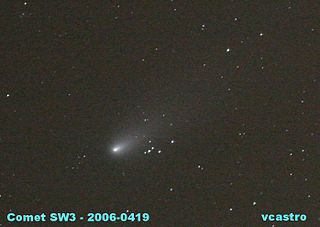
73P/Schwassmann–Wachmann, also known as Schwassmann–Wachmann 3 or SW3 for short, is a periodic comet that has a 5.4 year orbital period and that has been actively disintegrating since 1995. When it came to perihelion in March 2017, fragment 73P-BT was separating from the main fragment 73P-C. Fragments 73P-BU and 73P-BV were detected in July 2022. The main comet came to perihelion on 25 August 2022, when the comet was 0.97 AU from the Sun and 1 AU from Earth. It will be less than 80 degrees from the Sun from 25 May 2022 until August 2023. On 3 April 2025 it will make a modest approach of 0.3 AU to Jupiter. 73P will next come to perihelion on 23 December 2027 when it will be 0.92 AU from the Sun and on the far side of the Sun 1.9 AU from Earth.
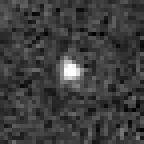
10370 Hylonome (; prov. designation: 1995 DW2) is a minor planet orbiting in the outer Solar System. The dark and icy body belongs to the class of centaurs and measures approximately 72 kilometers (45 miles) in diameter. It was discovered on 27 February 1995, by English astronomer David C. Jewitt and Vietnamese American astronomer Jane Luu at the U.S. Mauna Kea Observatory in Hawaii, and later named after the mythological creature Hylonome.
60558 Echeclus is a centaur, approximately 84 kilometers (52 miles) in diameter, located in the outer Solar System. It was discovered by Spacewatch in 2000 and initially classified as a minor planet with provisional designation 2000 EC98 (also written 2000 EC98). Research in 2001 by Rousselot and Petit at the Besançon observatory in France indicated that it was not a comet, but in December 2005 a cometary coma was detected. In early 2006 the Committee on Small Bodies Nomenclature (CSBN) gave it the cometary designation 174P/Echeclus. It last came to perihelion in April 2015, and was expected to reach about apparent magnitude 16.7 near opposition in September 2015.

1704 Wachmann, provisional designation A924 EE, is a stony asteroid from the inner regions of the asteroid belt, approximately 7 kilometers in diameter. It was discovered by German astronomer Karl Reinmuth at Heidelberg Observatory on 7 March 1924. It was later named after astronomer Arno Wachmann.

An extinct comet is a comet that has expelled most of its volatile ice and has little left to form a tail and coma. In a dormant comet, rather than being depleted, any remaining volatile components have been sealed beneath an inactive surface layer.
2011 MM4, provisional designation: 2011 MM4, is a sizable centaur and retrograde damocloid from the outer Solar System, approximately 64 kilometers (40 miles) in diameter. It was discovered on 24 June 2011, by astronomers with the Pan-STARRS 1 at the Haleakala Obs. in Hawaii.
Centaurus is a mission concept to flyby the centaurs 2060 Chiron and Schwassmann–Wachmann 1. It was submitted in response to the NASA Discovery program call for proposals in 2019 but ultimately was not among the four missions selected for further development by NASA in February 2020. If it had been selected, Centaurus would have been the first mission to attempt a flyby of a centaur.
P/2020 MK4 (PanSTARRS) is a Chiron-type comet or active centaur orbiting in the outer Solar System between Jupiter and Saturn. It was discovered on 24 June 2020, by the Pan-STARRS survey at Haleakala Observatory in Hawaii, United States.

C/2014 UN271 (Bernardinelli–Bernstein), simply known as C/2014 UN271 or Comet Bernardinelli–Bernstein (nicknamed BB), is a large Oort cloud comet discovered by astronomers Pedro Bernardinelli and Gary Bernstein in archival images from the Dark Energy Survey. When first imaged in October 2014, the object was 29 AU (4.3 billion km; 2.7 billion mi) from the Sun, almost as far as Neptune's orbit and the greatest distance at which a comet has been discovered. With a nucleus diameter of at least 120 km (75 mi), it is the largest Oort cloud comet known. It is approaching the Sun and will reach its perihelion of 10.9 AU (just outside of Saturn's orbit) in January 2031. It will not be visible to the naked eye because it will not enter the inner Solar System.
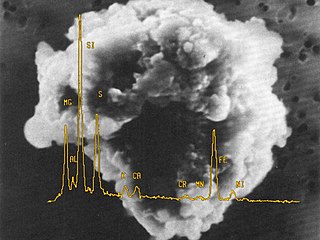
Dust astronomy is a subfield of astronomy that uses the information contained in individual cosmic dust particles ranging from their dynamical state to its isotopic, elemental, molecular, and mineralogical composition in order to obtain information on the astronomical objects occurring in outer space. Dust astronomy overlaps with the fields of Planetary science, Cosmochemistry, and Astrobiology.






















